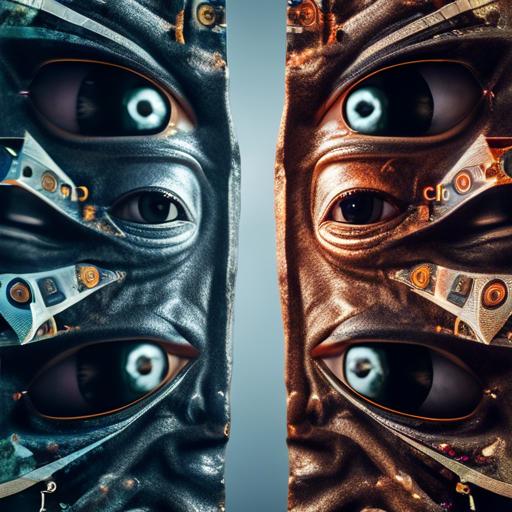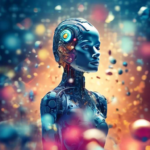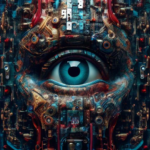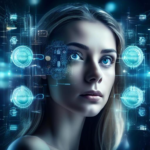In the ever-evolving landscape of visual storytelling, the quest for the perfect stock image is akin to an artist seeking the ideal brushstroke, a poet searching for the precise word. As businesses and individuals seek to capture attention, inspire emotions, and communicate messages with impact, the source of their visual content becomes a crucial choice between the tried and true versus the cutting edge. Enter the debate of our digital age: Traditional stock images versus AI-generated imagery.
Imagine a bustling marketplace where classic artisans showcase meticulously crafted wares, each piece steeped in history and human touch. Now envision a futuristic bazaar where seamless, algorithm-driven creations dazzle with innovation and endless possibility. Both worlds hold promise and potential, each with its own unique strengths and subtle nuances.
In this article, we will embark on an exploratory journey, comparing the authenticity and artistry of traditional stock photos with the pioneering spirit and limitless creativity of AI-generated visuals. Through supportive analysis and thoughtful examination, we aim to illuminate the path that best aligns with your creative goals and storytelling ambitions. Whether you are an entrepreneur, designer, or content creator, let us delve into this juxtaposition of tradition and technology, painting a clear picture of the future of stock imagery.
Table of Contents
- Exploring the Essence of Authenticity in Traditional Stock Photography
- Understanding the Artistic Versatility of AI-Generated Images
- Comparative Costs: Budgeting for Traditional vs. AI-Generated Images
- Time and Efficiency: A Look at Production Speed and Convenience
- Evaluating the Quality: Sharpening the Eye for Image Detail
- The Ethical Implications of Using AI in Image Creation
- Customization and Flexibility: Tailoring Images to Your Needs
- Industry Adoption: Real-world Applications and Success Stories
- Crafting the Perfect Strategy: Blending Traditional and AI-Generated Solutions
- The Way Forward
Exploring the Essence of Authenticity in Traditional Stock Photography
When examining the nuanced realm of traditional stock photography, one cannot overlook the profound sense of **authenticity** that these images capture. These snapshots not only tell stories but also embody real human moments, showcasing genuine emotions and scenarios. The beauty of traditional stock images lies in their ability to connect with viewers on a deeply personal level. This connection is forged through elements such as the natural interplay of light, the unfeigned expressions of models, and the tangible environments that ground these images in reality.
Traditional stock photography often thrives on capturing the ephemeral magic of everyday life. Here’s what sets these images apart:
- Human Touch: The presence of real people adds soul to the images, making them relatable and engaging.
- Diverse Scenarios: From bustling urban landscapes to serene rural settings, the variety is virtually limitless.
- Textural Quality: The tactile feel of real-world elements creates a sense of depth and immersion.
To illustrate the stark contrasts between traditional and AI-generated stock images, consider the following table:
| Aspect | Traditional Stock | AI-Generated Stock |
|---|---|---|
| Human Representation | Real models with genuine emotions | Simulated poses and expressions |
| Environmental Authenticity | Natural, real-world settings | Digitally constructed environments |
| Detail and Texture | Organic, tactile quality | High-resolution but lacks depth |
Traditional stock photography, despite its inherent flaws like occasional inconsistency and higher costs, remains a powerful medium for evoking **genuine emotions**. The rigor of capturing these moments, the artistry of lighting and composition, and the collaboration with professional photographers contribute to a sense of realism that is often unattainable through artificial means. When utilizing traditional stock images, brands and creatives can rest assured in the knowledge that their visuals possess an unrivaled level of authenticity, resonating deeply with their audience.
Understanding the Artistic Versatility of AI-Generated Images
One of the most striking aspects of AI-generated images is their **range of artistic styles**. From hyper-realistic photographs to abstract digital art, these creations showcase how artificial intelligence can adapt to various visual languages with remarkable precision. Traditional stock images, often captured by professional photographers, have their unique charm and authenticity. However, the **creative boundaries** of AI-generated images extend far beyond the lens, offering endless possibilities limited only by the input data and algorithms.
AI-generated images excel in meeting specific **aesthetic and thematic criteria** quickly and efficiently. For example, if you need an image of a surreal landscape or an out-of-this-world cityscape, an AI can generate multiple variations within minutes, each with its own unique details and enhancements. These images can be tailored to fit exact color schemes, compositions, and moods, something that may take considerable time and resources when produced traditionally.
- **Customization**: Tailor-made designs to suit specific needs
- **Consistency**: Uniform style and quality across multiple images
- **Speed**: Rapid generation of bulk content
Another fascinating aspect is the **collaborative potential** between human creativity and AI capabilities. Designers and artists can use AI-generated images as a starting point, modifying and enhancing them to create hybrid artworks that combine the best of both worlds. This symbiosis allows for exploring new artistic avenues and unlocking innovative design solutions that were previously unimaginable.
| Feature | Traditional Images | AI-Generated Images |
|---|---|---|
| Creation Time | Hours to days | Minutes |
| Flexibility | Limited by real-world factors | Virtually limitless |
| Cost | Varies (often higher) | Generally lower |
| Uniqueness | High | Customizable |
The **commercial application** of AI-generated images also presents new opportunities. E-commerce sites, marketing campaigns, and branding materials can benefit from visually diverse and unique content that stands out in a crowded market. By blending traditional and AI-generated images, businesses can create more engaging visual narratives that resonate with their audiences, striking a balance between authenticity and innovation.
Comparative Costs: Budgeting for Traditional vs. AI-Generated Images
When diving into the world of stock images, understanding the cost dynamics between traditional methods and AI-generated alternatives is essential. Traditional stock imagery often implies a labyrinth of costs, encompassing not only rights and licenses but occasionally custom photographic requests. These expenses can quickly escalate, especially if you’re sourcing high-quality or unique photographs. In contrast, AI-generated images promise to disrupt this pricing model with their streamlined production process and versatile scalability.
**Traditional Stock Image Costs:**
- **License and Rights Fees:** Depending on usage rights (commercial, editorial, etc.), expect varied pricing tiers.
- **Custom Photography:** Hiring a professional photographer, covering location fees, models, and post-processing.
- **Subscription Services:** Monthly or annual charges for access to a database of images, sometimes restrained by download limits.
**AI-Generated Image Costs:**
- **Subscription Plans:** Often much cheaper than traditional services, with companies offering flexible pricing models.
- **Pay-Per-Image:** Purchase only what you need without recurring subscription fees, typically at a lower price point.
- **Customization and Edits:** Minimal to no extra cost for edits since AI tools often include easy-to-use customization features.
| Expense Type | Traditional Stock Images | AI-Generated Images |
|---|---|---|
| License Fees | Variable & Often High | Fixed & Lower |
| Subscription Costs | High | Low to Moderate |
| Customization | Expensive | Low or No Extra Cost |
By shifting to AI-generated images, businesses and creatives can sidestep many traditional costs while enjoying the added benefit of rapid production and iteration. As technology continues to advance, AI-generated imagery options become more sophisticated and accessible, giving you robust tools to maintain visual quality without breaking your budget.
Time and Efficiency: A Look at Production Speed and Convenience
The advent of AI technology has revolutionized many industries, and stock image production is no exception. When it comes to **production speed** and **convenience**, AI-generated stock images are leagues ahead of traditional methods.
**Speed of Creation**
Traditional stock image production involves:
- Organizing photo shoots
- Hiring photographers, models, and stylists
- Post-production editing
This process can take days or even weeks. In contrast, AI-generated images can be produced in a matter of minutes, sometimes even seconds. With AI, you skip the entire logistical nightmare and go straight from concept to creation at lightning speed.
**Convenience**
AI offers unparalleled convenience:
- No need for physical setups or locations
- Instant modifications and adjustments
- A vast repository of styles and templates
Imagine needing a specific themed image for a campaign. With traditional methods, this might mean multiple photo shoots. AI, however, can instantly generate several variations of the theme, allowing you to select the perfect fit effortlessly.
| Aspect | Traditional Stock Images | AI-Generated Images |
|---|---|---|
| Speed | Days to Weeks | Minutes to Seconds |
| Flexibility | Limited by resources | High, instant adjustments |
| Cost | High | Low to Moderate |
The time-saving benefits are evident, but the impact on flexibility and cost-efficiency is equally profound. Traditional methods often come with high costs due to location fees, talent payments, and equipment rentals. AI-generated images have reduced these expenses significantly, democratizing access to high-quality visuals.
**Conclusion**
For businesses, marketers, and creatives, the advantages of utilizing AI-generated stock images are clear. Enhanced production speed, coupled with unmatched convenience, makes AI a game-changer. Imagine having the ability to generate practically any image you need, tailored to your precise requirements, all within moments. That’s the power of AI in stock image production.
Evaluating the Quality: Sharpening the Eye for Image Detail
Understanding the nuances in image quality often requires a discerning eye, especially when comparing traditional stock photos to AI-generated ones. One must carefully analyze various aspects, such as **sharpness and clarity**. Images produced by human photographers usually possess natural depth and intricate details because they often result from high-end camera equipment and meticulous editing.
Beyond technical details like resolution and focus, the emotional impact of an image plays a crucial role. Traditional photographs tend to capture genuine moments, often imbued with subtle storytelling elements. Conversely, AI-generated images can sometimes appear sterile or too perfect, lacking the spontaneous imperfections that give traditional photos their charm.
- **Texture and Patterns:** Human-taken photos often exhibit intricate textures and organic patterns, which can be challenging for AI algorithms to replicate authentically.
- **Lighting Effects:** The interplay of natural and artificial lighting is another area where traditional images generally excel. Photographers skillfully manipulate light to create mood and depth, whereas AI might struggle with nuanced shadows and highlights.
- **Color Balance:** AI-generated images may sometimes exhibit unnatural color tones or overly saturated hues, an artifact that sharp eyes can quickly discern against the more balanced and true-to-life color schemes in traditional images.
For detailed evaluation, consider the following comparative table:
| Aspect | Traditional Stock Photos | AI-Generated Images |
|---|---|---|
| **Sharpness and Clarity** | Consistently high | Varies, often less nuanced |
| **Emotional Depth** | Rich, nuanced | Can be lacking |
| **Texture Authenticity** | High, intricate | Sometimes artificial |
| **Lighting Control** | Masterful | Often basic |
| **Color Balance** | Natural | Sometimes exaggerated |
Ultimately, honing your ability to evaluate and distinguish between these two kinds of images involves appreciating these subtle yet significant differences. As AI tech evolves, this task may become more challenging, but by focusing on these key factors, one can develop a more refined and informed perspective.
The Ethical Implications of Using AI in Image Creation
As artificial intelligence continues to evolve, its applications in various fields, including image creation, have raised intriguing ethical questions. When we compare traditional stock images with AI-generated ones, several concerns come to the forefront. Notably, issues regarding originality, authenticity, and potential misuse deserve careful consideration.
Originality and Authenticity
Traditional stock images are the product of a human photographer’s creativity, vision, and technical skills. These photos often capture genuine moments and scenes, embedding a sense of authenticity that AI-generated images might lack. AI, on the other hand, creates images by learning from thousands of existing photos, which raises questions about the true originality of the generated content. Can an AI-generated image ever truly replicate the genuine emotion captured by a human artist?
Potential Misuse and Intellectual Property
Another ethical implication surrounds the potential misuse of AI-generated images. There is concern that AI can be used to create deepfakes or misleading visuals, which can spread misinformation or harm individuals’ reputations. Furthermore, the intellectual property rights of the original images used to train AI models need clarity. Artists and photographers whose work contributes to these AI systems should be recognized and fairly compensated. Otherwise, we risk undervaluing their contributions.
| Aspect | Traditional Images | AI-Generated Images |
|---|---|---|
| Creation | Manual | Automated |
| Originality | High | Variable |
| Risk of Misuse | Low | High |
Loss of Jobs and Undermining Skills
With the rise of AI-generated images, there’s a looming fear regarding the future of professional photographers and graphic designers. The ease and cost-effectiveness of AI tools might drive businesses to prefer them over human talent, leading to a decline in job opportunities. Additionally, there’s the risk of undermining the skillful work that goes into traditional photography, which often involves not just technical expertise but also emotional and artistic insight. As a community, it’s crucial to find a balance that acknowledges and preserves the value of human creativity.
- Supporting Emerging Artists: Provide platforms and opportunities for new talents to showcase their work.
- Ethical Training of AI Models: Ensure that AI systems are trained with proper consent and fair compensation for original creators.
- Balanced Usage: Promote the coexistence of traditional and AI-generated images, valuing both for their unique contributions.
Customization and Flexibility: Tailoring Images to Your Needs
The versatility of traditional stock images can often be limited by the availability of specific themes or contexts. You’re typically constrained by the existing library, and customization may require extensive photo editing skills or third-party services. With **AI-generated stock images**, the landscape shifts dramatically in favor of personalization and adaptability.
| Aspect | Traditional Stock Images | AI-Generated Images |
|---|---|---|
| Customization | Limited | High |
| Flexibility | Fixed Themes | Variable Concepts |
| Turnaround Time | Time-consuming | Instantaneous |
With AI-generated images, you can zero in on minute details or complex themes simply by providing specific keywords or descriptors. This considerably expands the creative possibilities, enabling you to tailor the visual content to align perfectly with your brand’s narrative or campaign goals. Whether you need **seasonal themes**, diverse **ethnic representations**, or niche **industry-centric visuals**, AI-generated stock offers an unparalleled toolbox for customization.
Furthermore, the sheer scalability of AI-generated image platforms means that you’re not bogged down by licensing constraints. Traditional stock often comes with stipulations on usage, but AI-generated counterparts cater to a more flexible environment, ensuring your content is unique and exclusive without the trappings of standard licenses.
Imagine requiring a series of images that feature an unusual combination of elements—perhaps a tech-savvy astronaut in a traditional marketplace. Such specific images are rare and might not exist in traditional stock databases, leading to expensive custom photoshoots. However, with AI, generating these unique visuals is not just possible but also efficient and cost-effective.
Industry Adoption: Real-world Applications and Success Stories
As businesses strive to distinguish themselves in saturated markets, the use of high-quality imagery becomes imperative. Industries across the spectrum, from e-commerce to entertainment, are witnessing the transformative power of AI-generated stock images. These innovative visuals are not merely placeholders; they are dynamic assets that convey brand narratives more effectively and affordably than traditional options.
- Retail and E-commerce: AI-generated images are empowering online stores to showcase products in diverse settings without the need for costly photoshoots. Companies can now generate multiple product scenarios to appeal to different demographics, enhancing user engagement and encouraging conversions.
- Real Estate: Realtors are utilizing AI-generated imagery to create virtual tours and staging options, allowing potential buyers to visualize properties in various styles and configurations. This improves the viewing experience and accelerates decision-making processes.
- Marketing and Advertising: Campaigns benefit immensely from AI-generated images tailored to specific audience segments. This customization enhances the relevance and relatability of ads, leading to improved click-through rates and ROI.
Several enterprises have already harnessed the power of AI-generated stock images with remarkable success. For instance, a fashion retailer reported a 25% increase in online engagement after incorporating AI-generated models wearing their collections. Without the limitations of traditional photoshoots, they could offer incredibly diverse representations of their clothing line, resonating with a broader customer base.
| Industry | Use Case | Outcome |
|---|---|---|
| Fashion | AI-generated models | 25% increase in online engagement |
| Real Estate | Virtual property staging | Accelerated decision-making |
| Advertising | Targeted ad visuals | Higher click-through rates |
The entertainment industry is another domain where AI-generated images are breaking new ground. Film studios and game developers employ these technologies to conceptualize scenes, characters, and settings swiftly. This accelerates the creative process and reduces pre-production costs. A prominent animation studio noted a 30% reduction in time spent on initial character designs, allowing for faster project turnovers and more innovative storytelling opportunities.
In a rapidly evolving digital landscape, the versatility and efficiency of AI-generated stock images position them as invaluable tools. They enable industries to pivot quickly, experiment boldly, and connect with audiences in ways that traditional imagery often cannot match. By embracing AI innovations, businesses are not merely keeping up with the times; they are setting the stage for future growth and success.
Crafting the Perfect Strategy: Blending Traditional and AI-Generated Solutions
Crafting a standout strategy often involves the interplay of tried-and-tested methods and modern innovations. When it comes to stock imagery, both traditional techniques and AI-generated solutions have their unique strengths and challenges. By skillfully blending these approaches, you can maximize the impact and relevance of your visual content.
**Traditional stock images** offer a plethora of medium and high-quality options, tailored for direct and specific uses. They have been meticulously shot by professional photographers, ensuring adherence to artistic and technical standards. Relying on such images can save time, as they often come with detailed metadata, allowing for easy searching and categorization. However, these can be costly, especially when dealing with niche or highly exclusive content. Also, there can be limitations in terms of diversity and cultural representation owing to preset stock image libraries.
- Professional shooting quality
- Easy categorization and searchability
- Higher costs for niche content
- Limited diversity in certain libraries
**AI-generated images**, on the other hand, have revolutionized the creative field with their ability to produce customizable and unique visuals on-demand. These images can simulate various artistic styles and fill specific creative needs with astonishing accuracy. Not only do they offer a significant reduction in cost and turnaround times, but they also help break the mold by incorporating innovative design elements previously unimaginable. However, AI imagery can sometimes lack the authentic ‘human touch’ and may present ethical dilemmas regarding the use of modeled data and copyright issues.
- Customization and uniqueness
- Cost-effective and quick turnaround
- Potential lack of authentic ‘human touch’
- Ethical and copyright considerations
| Aspect | Traditional | AI-Generated |
|---|---|---|
| Shooting Quality | High | Variable |
| Cost | Higher | Lower |
| Turnaround Time | Moderate | Instant |
| Customization | Limited | Extensive |
Finding the perfect balance in your strategy involves understanding when to leverage **traditional stock images** for their unparalleled quality and reliability, and when to utilize **AI-generated options** for their flexibility and innovation. This combination can drive both creativity and efficiency, resulting in a well-rounded and impactful visual content strategy.
The Way Forward
both traditional and AI-generated stock images have their own unique advantages and qualities. While traditional images offer a certain level of authenticity and originality, AI-generated images provide convenience and efficiency. Ultimately, the choice between the two depends on individual needs and preferences. Whichever option you choose, remember that creativity knows no bounds and innovation is always at your fingertips. So go ahead, explore the possibilities and unleash your imagination with stock images that inspire and captivate. Here’s to creating unforgettable visuals and taking your projects to new heights. Happy creating!































